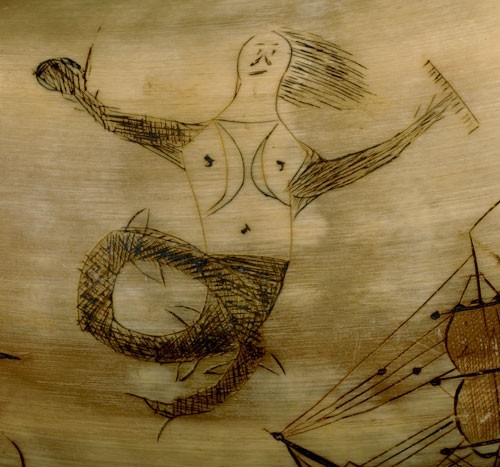
Detail from a powder horn, Jamaica, ca. 1820. (Noël Hume Collection; unless otherwise noted, all photos are by Gavin Ashworth.) This carving depicting a mermaid with the head of a manatee is probably the earliest “mermaid” rendering drawn from life.

Paving tile, England, fourteenth century. Red brick with pipe-clay inlay. Decorated with a mermaid holding a fish, this tile is part of the floor of the library at Litchfield Cathedral. (Photo, courtesy W. W. Rodwell.)

Paving tiles. Left: Netherlands, ca. 1570–1600. White engobe laid on coarse red brick clay; Flemish polychrome. 5" x 5" x 0.71". Found in 1919 in Tower Street, London. The two corner pinholes penetrate .55" into the tile, and the edges are slightly beveled. Center: Two four-tile panels, probably Rotterdam, ca. 1600–1630. Delftware; yellow clay, with tulip and pomegranate designs in monochrome and polychrome. 5.25" x 5.25" x .47". Two pinholes are visible in one of the tiles. Right: Netherlands, ca. 1600–1650. Delftware. 5.19" x 5.19" x .47". Slightly beveled, with polychrome tulip and fleur-de-lis corners and two pinholes.

Tile panel, Holland, ca. 1650. Delftware. Dutch tiles were used in panels as well as surrounds.

Ship tiles, Holland. Delftware. Left: Ca. 1680–1710. Yellow clay. 4.88" x 5" x .39". Showing a three-masted merchantman under half sail on a rippling sea, this tile has spider corners and two pinholes close to them. Center: Ca. 1650. Pale pink clay. Approx. 5" x 5" (thickness obscured by frame). This depiction of a three-masted warship in full sail with guns run out and four crewmen visible is striking for its realistic treatment of waves and spray and the care taken in drawing the rigging. The tile has spider corners with inset pinholes. Right: Ca. 1650–1700. Orange clay flecked with iron. 4.88" x 4.88" x .31". This tile illustrates a single-masted pinnace with two crewmen and a chevron sea. There is a pinhole .55" in from two of the oxhead corners.

Tile, Holland, ca. 1650–1700. Delftware; yellow clay. 5" x 5" x .43". The tile, which depicts three men seated in a rowboat, one wearing a fur hat, has oxhead corners and no visible pinholes; the edges are slightly beveled. The painting is crude and the colors diffuse.

Tile, Holland, ca. 1625–1650. Delftware; orange clay with iron inclusions. 5.27" x 5.27" x .43". Represented here is an aged Poseidon looking somewhat distraught. He is seated on an orb (possibly a pearl) and holding a sail while riding on a seashell pulled by a reined otter. The subject is outlined in manganese and filled in with two tones of pale blue. The sea and its spray are similarly treated. At each of the spider corners is an inset pinhole.

Tile, Holland, ca. 1680–1710. Delftware. 5" x 5" x .43". The standard Triton, shown here blowing into a seashell, is painted in two-tone blue. The tile has oxhead corners, two of which have inset pinholes, on a pink to yellow body with beveled edges.

Tile, Holland, ca. 1650. Delftware. 6.1" x 6.1" x .39". Aphrodite (Venus) catching the wind in her sail. She stands on an orb, perhaps a pearl, on a modified chevron sea. The tile has oxhead corners, and one inset pinhole is visible through the thick, heavily crazed glaze. The clay body is sandy pink.

Tiles, Holland. Delftware. Left: Ca. 1650–1700. 4.92" x 4.92" x .39". A Triton is depicted with his windblown, elderly wife, who reaches for an unidentified object in a diagonal sea. The clay body is yellow with beveled edges, the glaze blue-tinted and somewhat crazed. There are spider corners with two inset pinholes. Right: Ca. 1640–1670. 5" x 5" x .47". The subject—a Triton kissing an unresponsive mermaid in a diagonal sea—is painted in an unusually dark blue color, augmented with a lighter wash. Two pinholes are inset .67" from spider corners. The clay body is pale pink with a yellowish gray glaze, which, like the tile illustrated at left, is crazed in the top right corner.
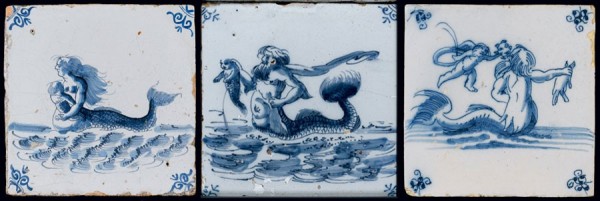
Tiles, Holland. Delftware. Left: Ca. 1640–1660. 5.11" x 5.11" x .39". The mermaid (Salacia?) shown on this tile suckles her merchild in a billowing sea. The clay is pale pink and beveled at the edges; two pinholes are set 1.02" in from the oxhead corners. Center: Ca. 1640–1660. 4.92" x 4.92" (thickness obscured by a frame). In this example a merman (Neptune?) endeavors to house-train his pup in a sea drawn in short blue dashes overlaid with darker hatching. This is a rare instance wherein the figure was drawn separately and the sea kept separate by a row of small dots and hooks. The tile has four pinholes set .78" in from the poorly defined oxhead corners. Right: Ca. 1690–1720. 4.88" x 4.88" x .39". A merperson of uncertain gender holds a small animal—perhaps a piglet—while reacting to a winged Nereid offering a diadem, all on a modified chevron sea. Compare the linear and cartoonlike treatment of the piscine body with that of the tile at far left, in which the scales were carefully drawn before applying the secondary wash. The bluish gray glazing is over a yellow body; spider corners, with two pinholes near beveled edges.

Tile, Holland, ca. 1630–1660. Delftware. Yellow clay. 5.11" x 5.11" (thickness obscured by a frame). A Triton and a mermaid are shown fighting with swords. One of them has the advantage of a shield. The figures are outlined in manganese, as are the ripples of the chevron-style sea. These figures (as well as mermaids on several other tiles) are distinguished by a stippled treatment of the fish scales under a solid blue wash. The spider corners are well executed and have two pinholes inset .66" from them. For another example from the same factory, see fig. 14, center.

Tile, Holland, ca. 1640–1670. Delftware. 5" x 5" x .39". Here a young Triton is blowing a conch shell and a Nereid waves a large flag while riding on a seashell drawn by a none-too-happy dolphin. They appear to be racing along and may have been the seventeenth-century Dutch version of today’s jet skiers. The figures are well drawn, as is the zigzag version of the chevron sea. In contrast, the oxhead corners are sloppily treated. The gray-blue glaze is crazed overall, and the clay is brick red; the edges are only slightly beveled. This tile is unusual in having four rather than two pinholes, set .59" in from the corners.

Tiles, Holland. Delftware. Left: Ca. 1660–1700. 4.92" x 4.91" x .35". Neptune bearing a trident is shown here riding on a closed seashell drawn by a scaly leopard whose head and shoulders are stippled. Behind Neptune stands a winged Nereid holding a small flag. The sea ripples to the right. The clay is yellow, the edges beveled; there are two pinholes .39" in from the oxhead corners. On the back, drawn in cobalt, is a large “64,” probably a dealer’s stock number. Center: Ca. 1630–1660. 5.11" x 5.11" (thickness concealed by a frame). Neptune rides an open seashell with an elaborate sunshade suspended over him. He holds the reins of a well-drawn turtle, the details of which are obscured by a lighter blue wash. The clay is yellow, and the figures are outlined in manganese—as is the sea, which is created from rows of zigzag lines. The spider corners are boldly executed, and there are two pinholes .66" in from them. See fig. 12 for a tile from the same factory. Right: Ca. 1650. 5.11" x 5.11" x .43". Represented here is a Triton riding on a wheeled sea chariot with a wind-baffling shell behind him, powered by a dolphin. In the chariot’s bow sits a winged Nereid holding reins and a whip. The sea is realistically treated with the crests of the waves in a reserve. The surface of the glaze is heavily crazed, pitted, and black-speckled, and there are spider corners with three pinholes well in from them. This may be an example of the surface condition that preceded the addition of kwaart. The clay, which is orange and visibly wedged, is beveled at the edges.

Tile, Holland, ca. 1680–1710. Delftware. 5.03" x 5.03" x .31". Jonah is shown in the jaws of a saber-toothed whale atop a chevron sea. The clay is yellow with beveled edges. Two pinholes are close to the spider corners.
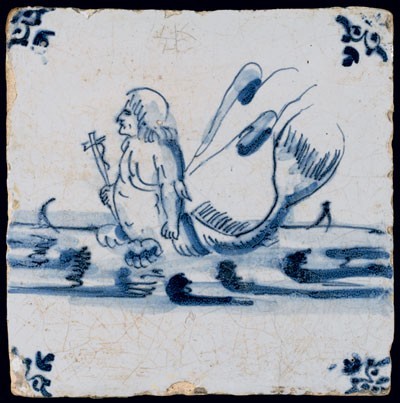
Tile, Holland, ca. 1650–1690. Delftware. 4.92" x 4.92" x .39". A mer-man with a forbidding face holds a cross (crucifix?) on a hooked sea; on the horizon are two yachts. The seventeenth-century Dutch, having thrown off Catholic idolatry, produced very few religiously oriented tiles. It is tempting, therefore, to see this grim merman as the personification of Catholic oppression. The clay is yellow, with beveled edges; two pinholes are set .59" in from the oxhead corners. There is some sub-surface crazing of the glaze.

Tiles. Delftware. Left: Probably London, ca. 1720–1740. 4.96" x 5.04" x .31". An English approach to the biblical flood, executed in blue. Animals, birds, and people are on their way to the ark as water rises in the foreground. The design is framed within two concentric circles and the corners are a rare stylized and hornless version of the Dutch oxheads. The clay is a sandy yellow, the edges are not beveled. There are four pinholes inset from the corners. Right: Holland, ca. 1800. 5.07" x 5.07" x .27". A less optimistic, Dutch version of the biblical flood executed in manganese, featuring the ark, the spire of a submerged church, miscellaneous floating debris, a man perhaps riding a sea horse, and, in the foreground, two despairing people—all within double concentric circles and oxhead corners. The clay is pinkish yellow, with beveled edges, and the glaze is tinted a pale purple by the manganese.

Tile, Holland, ca. 1660–1680. Delftware. 5.11" x 5.11" x .39". Left: The front shows a figure of uncertain sex who carries a spear and rides on a stylized strip of ocean. Right: The back is ornamented with enigmatic doodles, the largest being the letters SHI, which, if viewed in retrograde, would read IHS but for the S being reversed. The possible Christian symbolism is enhanced by reading the upper doodle as a cross drawn up out of the H. The fact that it is capped with a sunflower(?) and has one bird sitting on the lateral bar and another falling off it does not lend itself to such an interpretation, however. The two objects under the SHI might or might not be dice.
The front and back of this tile are poorly painted, the deep cobalt blue speckled and cracked beneath the glaze. The clay is pink with iron inclusions. The edges are sharply beveled, with two pinholes inset from the oxhead corners.
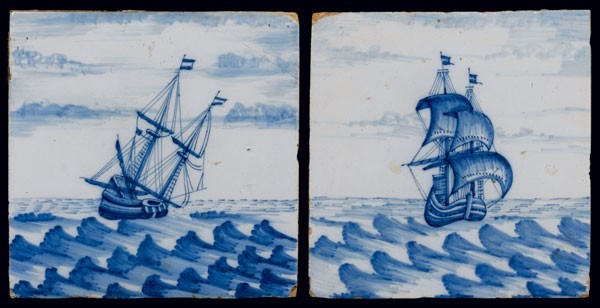
Tiles, Holland, 1850–1900. Approx. 6" x 6" x .27". Depicted is a pair of two-masted ketches, one with sails furled and the other under full sail; the foreground water is windswept, under realistically treated clouds. The clay is yellow with beveled edges; there are no pinholes or decorated corners.

Tile, Holland, ca. 1650–1680. Delftware. 4.72" x 4.72" (thickness and body color obscured by a frame). A distraught merman is shown searching for something with a torch in each hand. He is anatomically odd in that he has a fin growing out of his right thigh and sagging buttocks resembling female breasts. The remainder of his piscine body, however, is very carefully drawn, as are the ripples around him. The tile has spider corners, two of which are pierced by pinholes.

Tile, Holland, ca. 1650–1690. Delftware. 4.96" x 4.96" x .19". A determined-looking merperson with an attenuated neck, straight hair, and a dish-shaped hat, is squirting water (or milk?) from his (her?) breasts. The sea is drawn with straight lines, and possibly there is a weed-covered rock in the foreground. This most unusual figure is painted in dark blue outline and filled in with two tones of blue. Oxhead corners and two pinholes. The glaze is thick, kwaart-enriched, and heavily crazed. The clay body is a pale pink and very sandy, with slightly beveled edges. This tile is probably a product of an inexperienced factory.

Tile, Holland, ca. 1680–1710. Delftware. 5.03" x 5.03" x .39". A demoniac merman with horns and blue-filled face is wielding a club or broom. This forbidding monster rides on a straight-line sea. The clay is yellow; oxhead corners and two inset pinholes. There is crazing in the engobe under the glaze.

Plate, Holland, ca. 1650–1700. Delftware. D. 8.42". This shallow plate has a grayish glaze and is decorated with a standing figure of Aphrodite holding a billowing sail in the same hand that clutches a tress of her hair. She stands on a pearl in the midst of a calm sea. The back of the plate exhibits three sagger pin scars. See fig. 9 for a tile that shows a comparable image but of inferior quality.

Left: Dish, probably North Netherlands, ca. 1690–1710. Delftware. D. 10.62". This dish is decorated with a mermaid in a standard pose flanked by stylized sailing vessels, painted in a rich, dark blue. In the center are triangular stilt scars, and the stepped back and foot ring are lead-glazed. Right: Tile, Holland, ca. 1720–1750. 5.11" x 5.11" x .23". Here the basic tile mermaid holds a mirror but no comb; chevron water treatment. The tile has spider corners and two pinholes close to the slightly beveled edges. Its tin glaze is a pale bluish gray and the design a weak blue, with some discoloration due to having been mounted inside a fireplace.

Tile, Holland, ca. 1700–1740. Delftware. 5.04" x 5.04" x .31". A winged but armless siren is wearing an elaborate cap and, below her waist, something that could be a very short skirt or four bovine udders. The figure is flanked by five sailboats, and the sea is a modified chevron treatment, presumably portraying a parting of the waves. The palette is a pale, somewhat diffuse blue. The edges are slightly beveled, and there are oxhead corners with two near-to-edge pinholes.
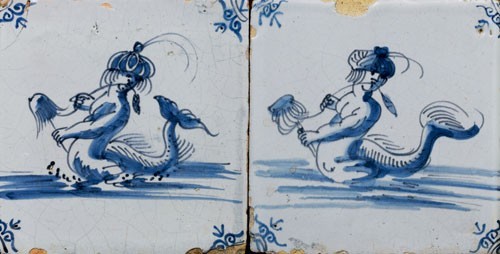
Tiles, Holland, ca. 1650–1700. Delftware; yellow clay. Left: 5.11" x 5.11" (thickness concealed by framing). Right: 5" x 5" (thickness concealed by a frame). Two treatments of the same subject, namely merpeople wearing elaborate bonnets and demonstrating how to spin flax without legs to grip the distaff (see fig. 27). The sea is treated as lateral stripes, one with spray and the other without it. There are dual pinholes set .59" in from the oxhead corners.

Woodcut, central Europe, ca. 1340. A woman spins with spindle and whorl, gripping the distaff between her thighs; at its top is a bundle of flax. Detail from the Velislae biblica picta, National Library of the Czech Republic, Prague.

Tile, Holland, ca. 1700. Delftware. 4.92" x 4.92" x .33". Yellow clay with beveled edges; possibly kwaart sealed. The tile is decorated with a stingray in a bellicose pose, the glazed ground a pale gray and crazed beneath the surface. There are oxhead corners and only one visible corner pinhole.

Tiles, Holland, 1640–1700. Delftware. 5"–5.11" x 5"–5.11" (thickness concealed by a frame). This eight-tile aquarium comprises a sea giraffe, two horses (one with braided mane), a unicorn, a dolphin, a shark, a walrus, and a winged dragon. Three of these yellow-body tiles have spider corners, the rest have oxheads; most have dual pinholes. The dragon has its pinholes far in from the corners (.98") and is arguably the earliest of the group.

Tile, Holland, ca. 1680–1710. Delftware. 5.04" x 5.04" x .35". A dramatic scene at sea occupies only the upper half of this tile. A departing mermaid leaves behind a drowning female wearing a black bra and water wings. A bird, probably dead, dangles from an overhead loop of string. Two of the spider corners have pinholes set .39" in from them. The clay is yellow with slightly beveled edges; the glaze is crazed and tinted blue.

Tile, Holland, ca. 1680–1700. Delftware. 4.84" x 4.96" x .31". The head of this sea creature resembles several in the engravings of Peter Bruegel the Elder, with its pointed ears, spouting nose, and straight hair. The wings are like those of a griffin, the chest is scaled, the legs are somewhat doglike, and the tail is reminiscent of peacock feathers. A lower fin has a similarly scrolled terminal. The sea is calm and small craft sail on it, a detail not seen until the late seventeenth century. The corners show rudimentary oxheads; there are no pinholes. The pink body has slightly beveled edges; the glaze is tinted blue.

Tile-lined fireplace at the Warner House, Portsmouth, New Hampshire, built 1716–1718. These fireplace tiles, attributable to ca. 1680–1725, were probably new when they were installed. Those in the top three rows are not originally from this fireplace, although they are contemporary with it. (Courtesy, Warner House Association; photo, Douglas Armsden.)
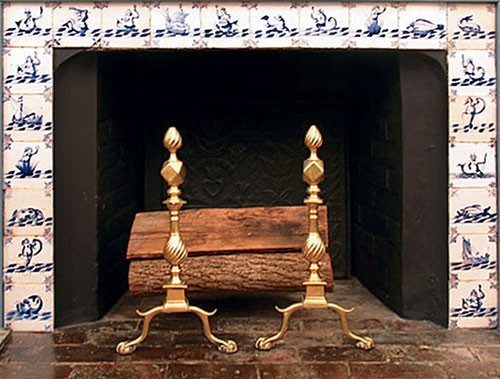
Original Dutch maritime and piscine tiles used in the re-created Dutch sitting room of a modern Pennsylvania home. (Photo, Ivor Noël Hume.)

Bathroom at the home of the author, decorated with Dutch delftware tiles that were reproduced from originals in the collection. All are attributable to ca. 1650–1700, with the exception of the ship panel, which was copied from a ca. 1800 pair removed from a Dutch farmhouse.
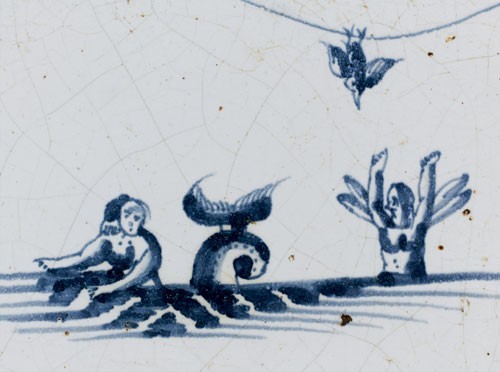
Detail of the tile illustrated in fig. 30.
